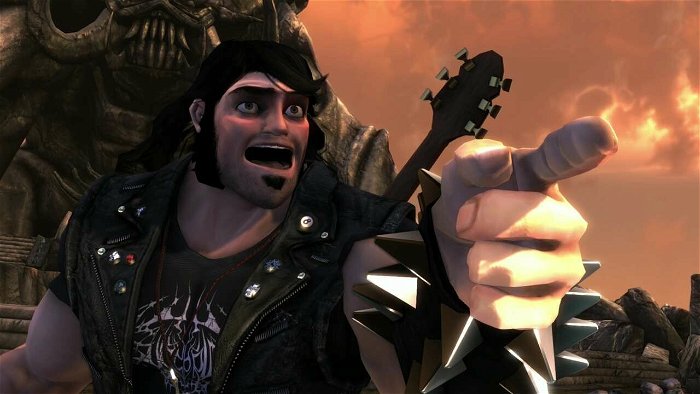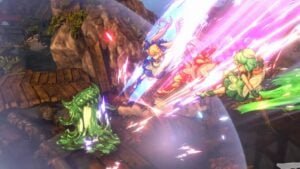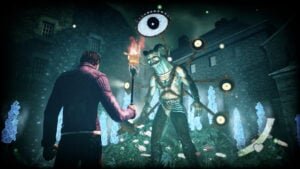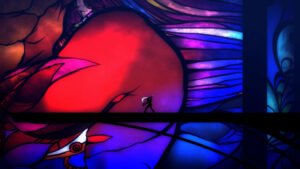Double Fine may not have the fiscal record of other blockbuster developers, but as far as critical acclaim, it is one of the most successful studios in the business.
Due to unique game development, unconventional humor, and a willingness to push graphics beyond photo-real constraints, Art Director Scott Campbell has reason to be proud of his company. CGMagazine caught up with Campbell while he was in town for the Toronto Comic Arts Festival.
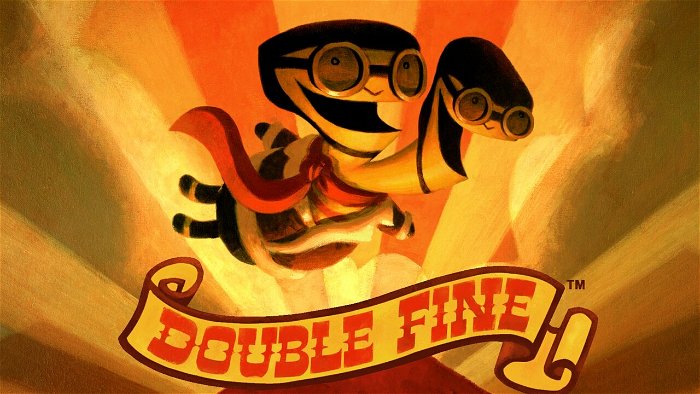
CGMagazine: So what brought you down to TCAF?
Scott Campbell: I’m here with Graham Annable. We’re selling our Hickee comics and my Double Fine Action Comics. It’s a web comic I do at Doublefine.com, and I’ve printed stuff from art shows I’ve had.
CGMagazine: This isn’t your first visit to TCAF, is it?
Scott Campbell: No, last year was my first one. I knew the reputation of it, it was a great show, and I came down last year and it was awesome. This is my favorite show. I think it’s amazing. My friend Dustin Harbin who runs Heroes-Con, he actually was saying “Oh yeah, this is the one,” and he knows a lot about the convention stuff. I got more involved with the comic stuff about two years ago. I would always kind of go to the west coast ones like SPX [Small Press Expo] once or twice, because I’m originally from San Francisco. But it wasn’t until going to Heroes and TCAF last year that I started to get super into the scene, and now I want to check them all out.
CGMagazine: So how did you get into art as a profession?
Scott Campbell: I’ve always been into art. I always painted when I was younger, I had drawing contests with my brother which I always won. I originally wanted to get into Marvel comics, because I was big into collecting comics, so that’s what I went to school for. But when I got college, I kind of shifted and stopped being into comics and got more into kid’s books and art galleries, different experiences and people that I was getting exposed to. My style kind of shifted, also. I was doing a more realistic style, I wanted to be an amazing draftsman, and then that shifted into doing more cartoony stuff.
CGMagazine: So then comic artists were actually a big influence on you?Scott Campbell: Yeah, Jim Lee, John Byrne, Marc Silvestri, Arthur Adams, Brett Blevins when he was doing New Mutants…anything to do with X-Men I was into. And I actually hated it when other people would guest pencil, like when Bill Sienkiewicz did the New Mutants and I was like, “This is not New Mutants!”
CGMagazine: You didn’t like Bill Sienkiewicz?
Scott Campbell: I didn’t. But then later on, I did like Bill. You know, your tastes change and stuff. I was so closed-minded with it, or one-track-minded, so when I went to school I wanted to be doing that sort of stuff, and I was really into Frank Frazetta, and I was also into Boris Vallejo, which I’m not too proud of, but you know, I wanted to draw epic dudes and ladies. I almost went down that path. Right after school, I was about to do an Alien versus Predator book and I…totally flailed somehow. I just got lazy, was thinking, “I don’t know…” and just lost track of it, ended up working in a pizza place. And then started working at Lucas doing video games because I had no real direction.
CGMagazine: That’s a big leap, from pizza to LucasArts. How did that happen?
Scott Campbell: After college…I think everyone had a similar experience, I did not know what do with my art skills at all, I was constantly visiting the school and asking, “Dude, what do I do?” A friend of mine started working in illustration at LucasArts and she became an animator, she didn’t even go to school for that. This was in ‘96, and she said there was a new company called Lucas Learning that was opening up and they were going to do kids edutainment Star Wars games. And at that point I thought, “All right, I’ll do that,” and did backgrounds. I painted backgrounds for these 2D games. And it was awesome, because it was Star Wars, but after four years, I was trying to figure out what do next. Then Tim [Schaefer] left to start Double Fine. I had met him…I think I’d started half-way through Grim Fandango, and he was working on that, and I’d go to the “Grim Fandango wall” where all the Peter Chan concepts were, he was my idol at that time. So I’d always go to that wall and learn how to use Photoshop, and he invited me to [join] when he started Double Fine, because he was interested in that style I was painting.
CGMagazine: Which leads us to Art Director at Double Fine now.
Scott Campbell: Yeah, it’s been Art Director. It’s shifted a little bit, like for Psychonauts, it was Art Director, overseeing all that stuff. For Brutal Legend we have this other guy now, Lee Petty, who was the official Art Director, he runs the show, the production. My title became more like Production Designer, so I oversaw the visual style of it, pre-production, getting the look of it together, and he realized it.
CGMagazine: How does the process start for you? When is it over on something like Brutal Legend?
Scott Campbell: Dude, strangely my job goes all the way to the end…but we’ll start this from the beginning. The pre-production phase is everyone’s favorite. For Brutal, we’d get together and just start throwing around ideas based on Tim’s initial concept of hot rods, a roadie back in time, and heavy metal. Those are the only things he knew he wanted, and once we were in the hardcore pre-production it was all about gathering reference. I’m hugely addicted to reference and inspiration before I get started, so I think it was about a month of me gathering reference and Tim bringing out his record collection. We had a room in the back where we covered the walls with art, cutting up things from magazines, Nordic landscapes, a lot of Frazetta up there, Viking stuff and weird heavy metal imagery. We created this heavy metal den we could chill out in. Before I could draw anything I had to establish that kind of vibe.
From there we had a team of about six artists. Peter Chan came down to work with us and we all got together and wrote down as many heavy metal ideas, the most preposterous combinations we could think of. And then everyone was drawing as much crazy stuff as possible. We were making like 40 games worth of stuff so we could just choose from the best of it. As we started going, we solidified it. Tim wrote this amazing back story about the history of this world, the creation of the earth, and that defined the reason for everything. I feel it’s super important when you’re creating a new world, that hasn’t been done before…you have to base it in reality. You can’t just have weird things and not have a reason for them to be there. You can’t just have a flying mountain that’s just there; it has to have a reason.
CGMagazine: So Tim’s Ormagoden creation myth was…
Scott Campbell: That was the basis for the whole thing. [Ormagoden] was heavy metal, he was made of heavy metal, he was made of hot rods, and he was made of fire. And the titans were another part of it, so there were layers and layers of epic things, like Lord of the Rings style, so you knew that generations and generations had come before…that’s my favorite thing. Because then you can put remnants of things in the world, and that’s what makes an environment in a movie, and especially in a game…what makes it so engrossing is when you can put those sorts of elements…so even if you see a campfire in area where someone was chilling, and you can think “What the…what were they doing here?” This world is alive, something has been here before. As it went along we sort of honed in on that, and we made our rules. Like everything could be envisioned on an album cover. A Motorhead album cover. So if Motorhead could use an image from the game on their album cover, it was a good concept. As the production went on and everyone hit their stride, my role was more of filling in what was needed for concepts for certain things, marketing, stuff like that.
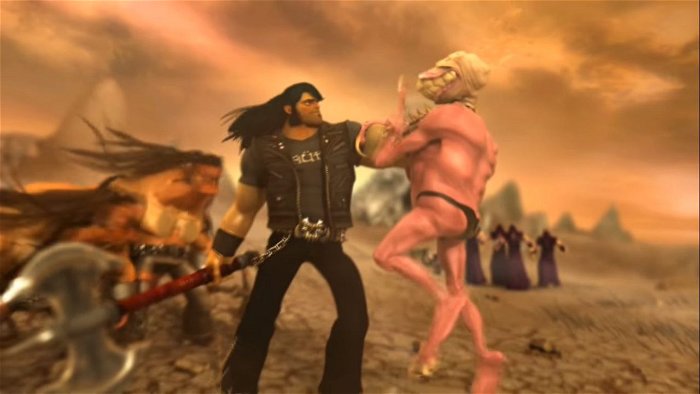
CGMagazine: On another note, most art design in games strives for a more photo-real look, but Double Fine doesn’t. What do you think of the obsession with photo-real?
Scott Campbell: I guess that’s part of the virtual reality thing, and feeling like you’re a part of a real world. I can see the allure of it; I like seeing that, too. But at some point, they’re going to get to the level where we’re looking at the most realistic games ever and they’re going to have to start changing it up. I’m not that concerned with it because I feel like there’s so much other stuff out there…there are so many awesome games like Indie games that are pushing a cool, unique style.
CGMagazine: Do you ever find that the requirements of game design can impose limitations on the art or the art style?
Scott Campbell: A lot of limitations; sometimes incredibly frustrating. There are times when I’m like “I just want to tell a story,” and not be concerned with what weapon is going to be in this guy’s hand, or he has to sit in this chair. But I go back and forth, because sometimes I’m frustrated and want to tell story and other times, I’m “Well, this is what the medium is, and it’s an awesome challenge to create a different experience.” I think those hurdles are a pretty interesting part of the medium and are pretty awesome.


